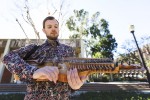Ryan Koons removes the nyckelharpa from its case leaning against the wooden wall of his family’s cabin in Maryland. As his fingers climb the small keys along the side of the instrument, his parents join in on the folksy tune and music fills the small, dimly lit room.
Outside the dining room walls of his childhood home, the ethnomusicology graduate student has continued to pursue a life of music.
Since the age of 5, Koons has played about 20 string and key instruments including the violin and the piano. One of the most complicated instruments he has learned to play is the Swedish nyckelharpa, a cross between a viola and a piano, with 16 different strings and about 37 individual wooden keys.
Koons’ parents began introducing him to folk music on the stages where they performed. At different gigs around Maryland, Koons’ family folk group, Wherligig, performed several European folk music repertoires including songs like “Harppolska” and “Pols Efter Brendlund Familj.” Koons said he would often find himself sitting backstage reading a book while his parents’ show went on onstage.
Afterward, Koons and his parents would return home and the sounds of guitar and hammered dulcimer would continue to twang, this time throughout the wooden walls of the family’s log cabin that Koons’ parents had built by hand.
Despite his extensive instrument background, Koons did not discover the nyckelharpa until 2006 when his mother showed him the folk group, Väsen.
“My first reaction was, ‘Oh, my God, I want to play that instrument,’” Koons said. “And my father’s first reaction was, ‘Oh, my God, I want to make that instrument,’ so we did.”
Utilizing a homemade nyckelharpa from his father, Koons began learning by ear while his fingers developed muscle memory moving up and down the small keys of the instrument.
After years of practice, Koons has gone on to join Wherligig. On stage at a small Irish pub or in front of a small crowd at an intimate house concert, Koons said he and his parents lose themselves in the melodies of their different instruments, smiling and playing off of each other’s improvisations.
Although currently busy with his dissertation, Koons still takes every opportunity to fly back to the East Coast and play music with his parents.
“Entering a new performance without my parents is like the difference between putting on a set of clothes that don’t fit very well and putting on a set of clothes that are tailored for you,” Koons said. “(Performing with them) is very, very enjoyable.”
Compiled by Nate Nickolai, A&E contributor.

A cross of a viola and piano? I don’t think so. Neither were invented when the first Nyckleharpa was concieved. (1400) The reporter should have said, “It is played with keys to make the notes and bowed to vibrate the strings.